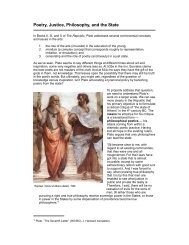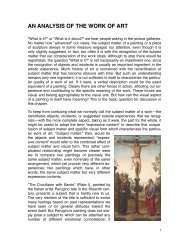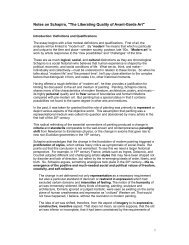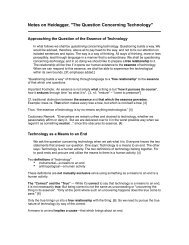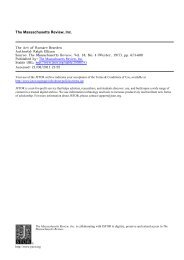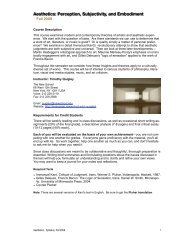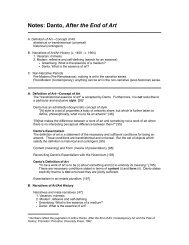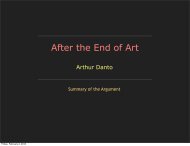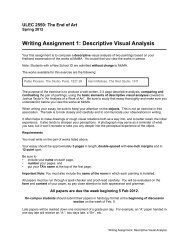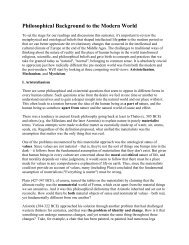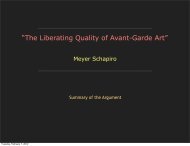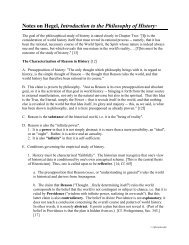You also want an ePaper? Increase the reach of your titles
YUMPU automatically turns print PDFs into web optimized ePapers that Google loves.
from Lascaux to our time, pure or impure, figurative or not, painting celebrates no otherenigma but that of visibility.Here M-P begins weaving in the“invisible” to that which is “visible”.“pauses, interruptions, or breaks.”Cf. Heidegger—language is thehouse of Being.Cf. Clement Greenberg.Abstraction is neither the issue nor acounterexample.“private world”“shared world”“incompatible”What we have just said amounts to a truism. The painter's world is a visible world,nothing but visible: a world almost mad, because it is complete though only partial.Painting awakens <strong>and</strong> carries to its highest pitch a delirium which is vision itself, for tosee is to have at a distance; painting extends this strange possession to all aspects ofBeing, which must somehow become visible in order to enter into the work of art. When,apropos of Italian painting, the young Berenson spoke of an evocation of tactile values,he could hardly have been more mistaken; painting evokes nothing, least of all the tactile.What it does is entirely different, almost the inverse. It gives visible existence to whatprofane vision believes to be invisible; thanks to it we do not need a "muscular sense" inorder to possess the voluminosity of the world. This voracious vision, reaching beyondthe "visual givens," opens upon a texture of Being of which the discrete sensorialmessages are only the punctuations or the caesurae. The eye lives in this texture as aman in his house.Let us remain within the visible in the narrow <strong>and</strong> prosaic sense. The painter, any painter,while he is painting, practices a magical theory of vision. He is obliged to admit thatobjects before him pass into him or else that, according to Malebranche's sarcasticdilemma, the mind goes out through the eyes to w<strong>and</strong>er among objects; for he neverceases adjusting his clairvoyance to them. (It makes no difference if he does not paintfrom "nature"; he paints, in any case, because he has seen, because the world has atleast once emblazoned in him the ciphers of the visible.) He must affirm, as onephilosopher has said, that vision is a mirror or concentration of the universe or that, inanother's words, the idios kosmos opens by virtue of vision upon a koinos kosmos; inshort, that the same thing is both out there in the world <strong>and</strong> here at the heart of vision—the same or, if you will, a similar thing, but according to an efficient similarity which is theparent, the genesis, the metamorphosis of being into its vision. It is the mountain itselfwhich from out there makes itself seen by the painter; it is the mountain that heinterrogates with his gaze.What exactly does he ask of it? To unveil the means, visible <strong>and</strong> not otherwise, by whichit makes itself mountain before our eyes. Light, lighting, shadows, reflections, color, allthese objects of his quest are not altogether real objects; like ghosts, they have onlyvisual existence. In fact they exist only at the threshold of profane vision; they are notordinarily seen. The painter's gaze asks them what they do to suddenly cause somethingto be <strong>and</strong> to be this thing, what they do to compose this talisman of a world, to make ussee the visible. The h<strong>and</strong> pointing toward us in The Nightwatch is truly there only whenwe see that its shadow on the captain's body presents it simultaneously in profile. Thespatiality of the captain lies at the intersection of the two perspectives which areincompossible <strong>and</strong> yet together. Everyone with eyes has at some time or other witnessedthis play of shadows, or something like it, <strong>and</strong> has been made by it to see things <strong>and</strong> aspace. But it worked in them without them; it hid to make the object visible. To see theobject, it was necessary not to see the play of shadows <strong>and</strong> light around it. The visible inthe profane sense forgets its premises; it rests upon a total visibility which is to berecreated <strong>and</strong> which liberates the phantoms captive in it. The moderns, as we know, haveliberated many others; they have added many a muted tone to the official gamut of ourmeans of seeing. But the interrogation of painting in any case looks toward this secret<strong>and</strong> feverish genesis of things in our body.And so it is not a question asked of someone who doesn't know by someone who does—the schoolmaster's question. The question comes from one who does not know, <strong>and</strong> it isaddressed to a vision, a seeing, which knows everything <strong>and</strong> which we do not make, for itmakes itself in us. Max Ernst (with the surrealists) says rightly, "Just as the role of thepoet since [Rimbaud's] famous Lettre du voyant consists in writing under the dictation ofwhat is being thought, of what articulates itself in him, the painter's role is to circumscribe<strong>and</strong> project what is making itself seen within himself".[8] The painter lives in fascination.5



